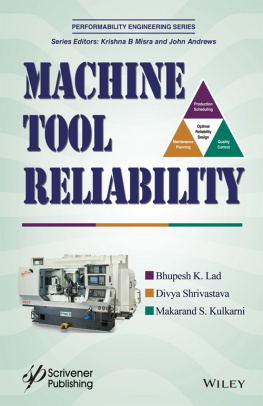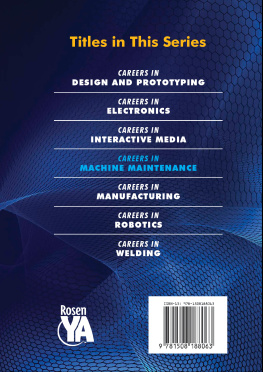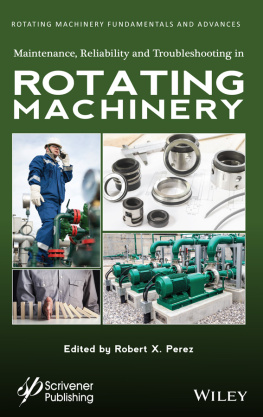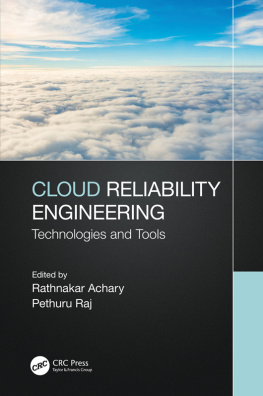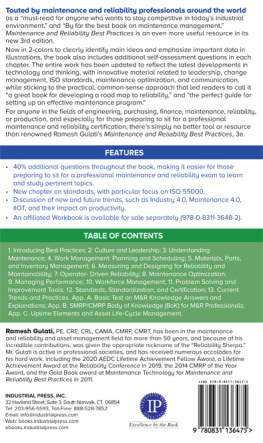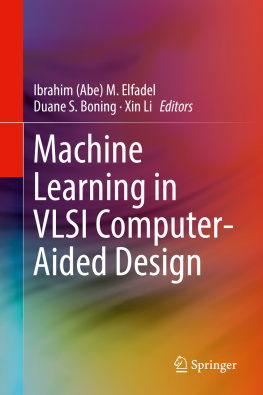Machine Tool Reliability
Scrivener Publishing
100 Cummings Center, Suite 541J
Beverly, MA 01915-6106
Performability Engineering Series
Series Editors: Krishna B. Misra ()
and John Andrews ()
Scope: A true performance of a product, or system, or service must be judged over the entire life cycle activities connected with design, manufacture, use and disposal in relation to the economics of maximization of dependability, and minimizing its impact on the environment. The concept of performability allows us to take a holistic assessment of performance and provides an aggregate attribute that reflects an entire engineering effort of a product, system, or service designer in achieving dependability and sustainability. Performance should not just be indicative of achieving quality, reliability, maintainability and safety for a product, system, or service, but achieving sustainability as well. The conventional perspective of dependability ignores the environmental impact considerations that accompany the development of products, systems, and services. However, any industrial activity in creating a product, system, or service is always associated with certain environmental impacts that follow at each phase of development. These considerations have become all the more necessary in the 21st century as the world resources continue to become scarce and the cost of materials and energy keep rising. It is not difficult to visualize that by employing the strategy of dematerialization, minimum energy and minimum waste, while maximizing the yield and developing economically viable and safe processes (clean production and clean technologies), we will create minimal adverse effect on the environment during production and disposal at the end of the life. This is basically the goal of performability engineering.
It may be observed that the above-mentioned performance attributes are interrelated and should not be considered in isolation for optimization of performance. Each book in the series should endeavor to include most, if not all, of the attributes of this web of interrelationship and have the objective to help create optimal and sustainable products, systems, and services.
Publishers at Scrivener
Martin Scrivener ()
Phillip Carmical ()
Copyright 2016 by Scrivener Publishing LLC. All rights reserved.
Co-published by John Wiley & Sons, Inc. Hoboken, New Jersey, and Scrivener Publishing LLC, Salem, Massachusetts.
Published simultaneously in Canada.
No part of this publication may be reproduced, stored in a retrieval system, or transmitted in any form or by any means, electronic, mechanical, photocopying, recording, scanning, or otherwise, except as permitted under Section 107 or 108 of the 1976 United States Copyright Act, without either the prior written permission of the Publisher, or authorization through payment of the appropriate per-copy fee to the Copyright Clearance Center, Inc., 222 Rosewood Drive, Danvers, MA 01923, (978) 750-8400, fax (978) 750-4470, or on the web at www.copyright.com . Requests to the Publisher for permission should be addressed to the Permissions Department, John Wiley & Sons, Inc., 111 River Street, Hoboken, NJ 07030, (201) 748-6011, fax (201) 748-6008, or online at http://www.wiley.com/go/permission .
Limit of Liability/Disclaimer of Warranty: While the publisher and authors have used their best efforts in preparing this book, they make no representations or warranties with respect to the accuracy or completeness of the contents of this book and specifically disclaim any implied warranties of merchantability or fitness for a particular purpose. No warranty may be created or extended by sales representatives or written sales materials. The advice and strategies contained herein may not be suitable for your situation. You should consult with a professional where appropriate. Neither the publisher nor author shall be liable for any loss of profit or any other commercial damages, including but not limited to special, incidental, consequential, or other damages.
For general information on our other products and services or for technical support, please contact our Customer Care Department within the United States at (800) 762-2974, outside the United States at (317) 572-3993 or fax (317) 572-4002.
Wiley also publishes its books in a variety of electronic formats. Some content that appears in print may not be available in electronic formats. For more information about Wiley products, visit our web site at www.wiley.com .
For more information about Scrivener products please visit www.scrivenerpublishing.com .
Library of Congress Cataloging-in-Publication Data:
ISBN 978-1-119-03860-3
Preface
Reliability engineering as a subject matter is developed vastly in last few decades. Numerous books have been published on the subject, discussing basic principles, theories, models, tools and techniques, in general. However, every system is unique and some of them may require specific treatment while applying various tools and techniques of reliability engineering. This book explores the domain of reliability engineering for one such very important industrial system, called machine tools.
Machine tools are at the heart of the manufacturing systems. Manufacturing industries rely on machine tools to fulfil their customers demand. Failure of machine tool hampers their production efficiency and creates uncertainties in managing the shop floor operations resulting into significant economic losses. Moreover, the users of such systems are now sharing the risk of failures with the machine tool manufacturers by engaging into long term maintenance or availability contracts. This has created new business avenue for machine tool manufacturers for Servicizing their traditionally product focused business. Machine tool manufacturers have the opportunity to package effective life cycle maintenance services with the hardware products, i.e. machine tools. It is therefore important for machine tool manufactures as well as users to focus on core of reliability engineering to model machine tools failure/repair and its interaction with other measures of system performances.
This advanced text on machine tool reliability modelling aims to provide a consolidated volume on various dimensions of machine tool reliability and its implications from manufacturers and users point of view. From manufacturers point of view novel methodologies for reliability and maintenance based design of machine tools are covered. From users point of view novel methodologies are presented to integrate reliability and maintenance of machine tools with production scheduling and quality control. Application area, i.e. machine tools is very important and it covers entire manufacturing sector.
The target audience of the book are researchers and practicing engineers in the field of reliability engineering and operations management. The book can also be helpful to undergraduate students in the area of reliability to get an application flavour of the subject. It opens up various research dimensions for researchers. All the approaches are illustrated with the help of numerical examples. This makes the approaches easy to understand.
This book does not intend to provide coverage to basic of reliability engineering. It is expected here that the readers have some basic knowledge of the reliability engineering, probability and statistics. However, Chapter 2 is provided for the reader to refresh their basic of probability and statistics required to follow the text.

